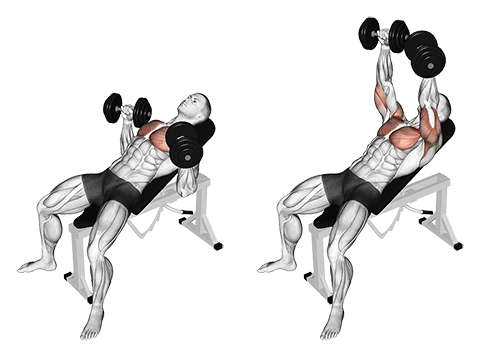Introduction
The flat bench gets all the love, but if you want a chest that pops in a t-shirt, you can’t ignore the incline dumbbell press. By pressing at an upward angle, you shift more work to the upper chest (clavicular pec fibers) and the front delts — creating that “full chest” look.
I added this exercise to my own routine after years of only barbell pressing, and the difference was night and day. Plus, dumbbells force each side to pull its weight (literally), which helps fix imbalances.
Muscles Worked
- Primary: Upper chest (pectoralis major, clavicular head)
- Secondary: Anterior deltoids, triceps
- Stabilizers: Core and shoulder stabilizers (since dumbbells don’t balance themselves)
How to Do the Incline Dumbbell Press
- Set the bench angle to about 30–45°. Higher than that, and it turns into a shoulder press.
- Sit back with dumbbells resting on your thighs. Kick them up as you lie back.
- Grip & position: Hold the dumbbells just outside chest width, palms forward. Keep your shoulders retracted and feet planted.
- Press upward and slightly in, aiming to bring the dumbbells toward each other at the top.
- Lower slowly until elbows are just below parallel to the bench.
- Repeat, keeping control. Don’t bounce or let shoulders roll forward.
💡 Cue to remember: “Press up and in, not just up.”
Common Mistakes to Avoid
- Bench too steep: Anything over ~45° shifts tension to shoulders.
- Flared elbows: Stressful on shoulder joints — keep them ~45° from your torso.
- Half reps: Lower until your elbows are at least level with the bench.
- Bouncing off chest: Control the weight through the full range.
Variations & Alternatives
- Barbell incline press → more load, less range of motion.
- Low-incline dumbbell press → gentler on shoulders.
- Machine incline press → stable path, good for going heavy.
- Incline fly → great as a finisher to fully fatigue upper chest.
Programming Tips
- Best rep range: 6–12 reps for muscle growth.
- Sets: 3–4, depending on total chest volume.
- Placement: Early in push or chest day, right after bench or as the main lift.
- Progression: Add small weight jumps once you can consistently hit the top of your rep range.
👉 In Volym, you can track this automatically — Auto Progression will adjust targets so you’re not just stuck on “3x10 forever.”
When Should You Use It?
- If your upper chest lags, this is your fix.
- If barbell incline bothers your shoulders, dumbbells offer a friendlier range.
- Great for lifters who want balanced chest development and better shoulder stability.
30–45° is ideal. Too steep = more shoulders than chest.
Dumbbells give more range of motion and balance work. Barbell allows heavier loads. Both have a place.
Not if you keep elbows tucked slightly and avoid too steep an angle. Start light and build up.
For hypertrophy, use a weight you can control for 6–12 reps. Save the heavy low-rep work for flat barbell bench.


